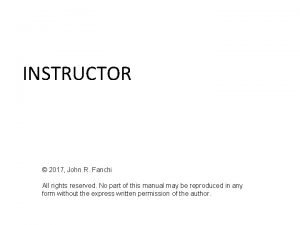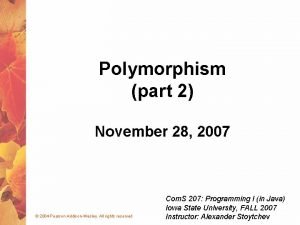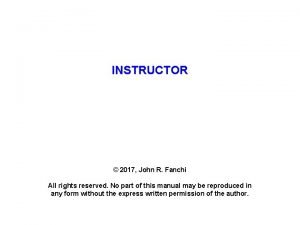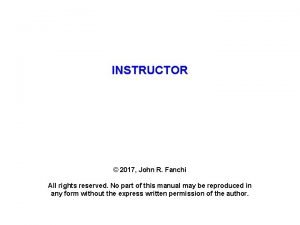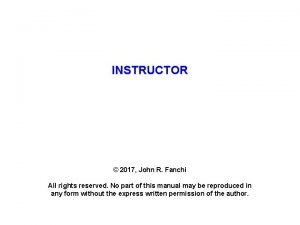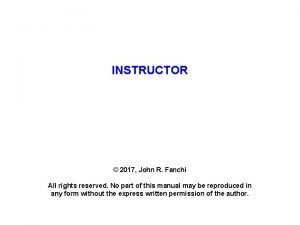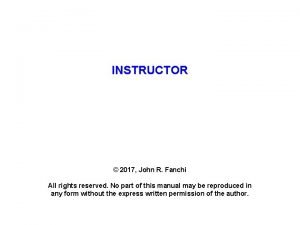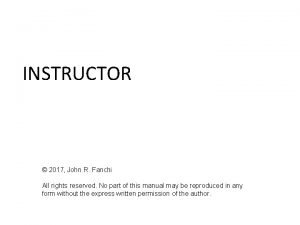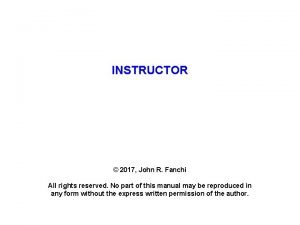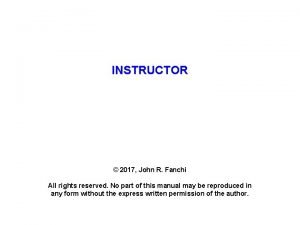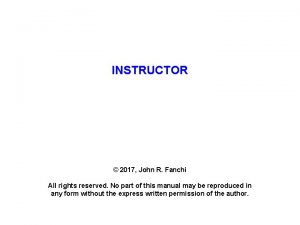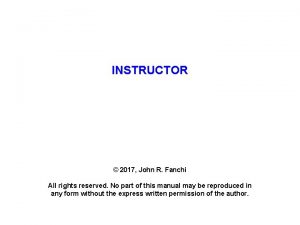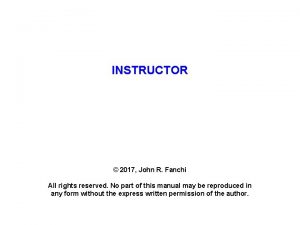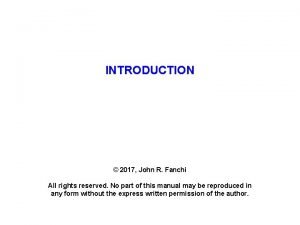INSTRUCTOR 2017 John R Fanchi All rights reserved














































- Slides: 46

INSTRUCTOR © 2017, John R. Fanchi All rights reserved. No part of this manual may be reproduced in any form without the express written permission of the author.

To the Instructor The set of files here are designed to help you prepare lectures for your own course using the text Introduction to Petroleum Engineering, J. R. Fanchi and R. L. Christiansen (Wiley, 2017) File format is kept simple so that you can customize the files with relative ease using your own style. You will need to supplement the files to complete the presentation topics.

WELL COMPLETIONS © 2017, John R. Fanchi All rights reserved. No part of this manual may be reproduced in any form without the express written permission of the author.

Outline Ø Casing Ø Cementing Ø Types of Completions Ø Perforating Ø Workovers Ø Stimulation Ø Hydraulic Fracturing Ø Artificial Lift Homework: IPE Ch. 10

CASING

Well Completion Ø Procedure to Prepare Well for Production Ø Decision: complete or plug & abandon Ø Issues to consider Ø Ø Ø Which formations should be isolated? Open hole or cased hole? Perforating design? Stimulate? (if necessary) Sand Control? (if necessary) Test well?

Casing Design Ø Keep hole from collapsing over its life Ø Complete production conduit from reservoir to surface Ø Protect shallow zones from heavy mud weights Ø Allow for future well stimulation Ø e. g. casing must withstand pressure of frac treatment

Wellbore

Wellbore Diagram for Vertical Well Concentration (ppm) Fresh water < 1, 000 Brackish water 1, 000 to 35, 000 Brine > 35, 000 Source: Hyne (2012, pg 18)

Casing Strings Surface + Production Surface + Intermediate + Production

CEMENTING

Cement Bond Log Ø Uses acoustic signals to detect cement behind pipe Ø Determines quality of bond Ø good bond, poor bond, no bond Ø Determines top of cement Ø Requires interpretation, so user beware

TYPES OF COMPLETIONS

Types of Completions Ø Ø Ø Cased Hole Open Hole Liners and Tiebacks Tubingless Dual zone and commingled zones

Sand Control Ø Suppose formation sand (e. g. from unconsolidated rock) flows into wellbore Ø Plugs pores and restricts or stops fluid flow Ø Increases damage to tubing Ø Causes surface equipment to sometimes plug up Ø Methods to Control Sand Ø Screening with gravel and metal screens Ø Chemical consolidation, e. g. resin coating Ø Frac Pacs Ø Sand control usually causes reduction in production rate

PERFORATING

Perforating Ø Purpose of Perforating Ø Create passage for oil/gas to flow into wellbore A. Position perforating gun B. Blast holes through pipe and cement into target formation C. Flow into wellbore Source: www. geomore. com, accessed April 2013

Perforating Design Ø Hole size & shot density (holes per foot) are basic to design Ø e. g. 4 shots/foot is fairly dense Ø Design should include estimate of stimulation and production rates Ø Casing may be pre-perforated or slotted before running Ø Must design for intervals of interest

Formation Damage Ø Producing rock is altered in a way that reduces flow of hydrocarbons into wellbore Ø Types of Damage Ø Fluid damage Ø Drilling mud filtrate or other fluid fills pore space Ø Causes changes in perm and relative perm Ø Solids damage Ø Fines plug up pore spaces, e. g. mud cake Ø Scale buildup on perfs and in formation

WORKOVERS

Workover Ø Repair or replace equipment Ø Sucker rod string Ø Downhole pump Ø Tubing Ø Cleanout well Ø Sand Ø Scale (salt) Ø Wax

STIMULATION

Well Stimulation Ø Purpose: Increase productivity Ø Methods Ø Explosive Fracturing Ø Acidizing Ø Hydraulic Fracturing

Acidizing Ø Acid “soak” near wellbore can remove damage Ø Acid frac (deep penetration) in limestones Ø Limestone will dissolve Ø Create improved pathways; e. g. Middle East

Types of Acid Ø HCL common Ø Ø Typically use about 1, 500 gals of 15% HCl Aids in frac after clearing perforations and borehole wall Must be careful when producing spent acid Excellent for dissolving lime scale buildup (Ca. CO 3) Ø Other types Ø Citric – weak clean up acid Ø Hydrofluoric acid (difficult to handle; dissolves glass)

HYDRAULIC FRACTURING Near Mansfield, TX

Wellbore Stress Sv Sh SH Vertical SH Horizontal Orientation of three principal stresses

Directions of Sh and SH Borehole Breakout: Determine direction of Sh using dipmeter and caliper logs in previously drilled wellbores σhmin σhmax σv Stress Orientation σhmax σhmin Plan View Ø Observe wellbore failure in direction of σhmin Ø σhmax is transverse to σhmin Ø Plan well azimuth in direction of minimum horizontal stress σhmin Ø σv > σhmax > σhmin

Gel Frac Ø Gel fracs combine water and polymer Ø Thicken injected fluid so it can carry significant amount of proppants into formation Ø Injection pressure must exceed fracture pressure

Slick Water Frac Ø Slick water fracs combine water with a friction-reducing chemical additive Ø The additive allows water to be pumped faster into the formation. Ø Water fracs do not use any polymers to thicken so the amount of proppant used is significantly less than that of gels. Ø Slick water fracs work very well in low-permeability reservoirs Ø Injection pressure must exceed fracture pressure

Proppant Ø Blend proppant (sand, beads, etc. ) with water Ø Proppant stays in fracture to prevent it from closing (healing) after pumping ceases Ø Proppant must be strong enough not to collapse (or be crushed) under forces trying to heal fracture Ø Propped fracture becomes flow conduit Ø Propped frac should increase rate of fluid flow to producer

Approximate Closure Pressure Limits for Proppant Categories Proppant Sand Resin-Coated Sand Intermediate Strength Ceramic High Strength Ceramic Closure Pressure Limit, psi 4, 000 8, 000 Temperature Limit, ˚F NA 250 10, 000 NA >12, 000 NA

Water Production from a Shale Well Ø Influenced by Ø Formation rock and fluid Ø Fracturing fluid Ø Typical constituents Ø Ø Suspended solids Dissolved solids Organics, e. g. hydrocarbons Residual-fracturing-fluid chemicals Ø Disposition of produced water Ø Recycle Ø Disposal

Video Hydraulic Fracturing Marathon Youtube video (6. 5 mins) http: //www. youtube. com/watch? v=VY 34 PQUiw. OQ&feature =player_embedded# Baker-Hughes Composite Plug Youtube video (7 mins) http: //www. youtube. com/watch? v=o. Pg. Zn. Zqp 87 k

Classification System for Fracturing Treatment Types Fracture Treatment Definition (Types 1 to 6 transport proppant into hydraulic fracture) 1. Conventional Use a gelling agent and one or more crosslinkers 2. Water Frac Use a friction reducer, a gelling agent, or a viscoelastic surfactant 3. Hybrid Use combination of friction reducer, gelling agent, acid-gelling agent, or crosslinker(s) 4. Energized Incorporate an energizer, normally N 2 or CO 2, into base fluid to generate foam 5. Acid Frac Use a gelled-acid base fluid to etch away formation rock and transport proppant 6. Gas Frac Use a gas, normally propane, as base fluid to transport proppant 7. Matrix Acidizing Use acid to etch away formation rock to increase oil or gas well productivity Source: SPE 163875, JPT (Mar 2014), pg. 110

Typical Fracture Treatment Ø Pre-frac testing gives rate and pressure data Ø Pump job in stages Ø Lead in – no proppant mixed in Ø Followed by gelled water with proppant in low concentration – 1 or 2 ppg Ø Followed by more stages of gelled water with increasing concentrations of proppant Ø Tail in with high concentration at end up to 7 -8 ppg

Planning the Job Ø Determine type of fluid Ø Gelled, slick, foam, condensate, CO 2. Ø Types of gelling agents, friction reducers, bactericides, corrosion inhibiters and other additives Ø May use foam, oil or condensate instead of water Ø Determine amount of water and proppant to be pumped Ø Rate of treatment – bbls / minute Ø Estimate rate and pressure needed to exceed frac gradient Ø Desired rate determines horsepower required Ø Consider safety, logistics and contingencies

Fracking may not be successful Source: JPT (Mar 2014), pg. 87

Fracture Treatment Issues Ø Size of Job Ø Small Job = 30, 000 gals and 50, 000 lbs proppant Ø Large job = 500, 000 gals and 1, 000 lbs proppant Ø Deep wells Ø Sand proppant can be crushed in deep treatments Ø Need special proppant (e. g. bauxite) Ø Should fluid be pumped down casing or tubing? Ø Typically casing ID > tubing ID Ø Casing gives better rate but at lower pressures Ø Tubing allows high pressures but low rate

Video Hydraulic Fracturing http: //www. youtube. com/watch? v=m. JGihw. JFIWU Western Energy footage, 7. 5 minutes IPAMS International Petroleum Association of Mountain States

Stimulation Guide Natural Completion Stimulation not needed, e. g. undamaged, high quality rocks such as the Gulf Coast Matrix Acidizing Cleans up perforating debris & formation damage Acid Frac Primarily in limestones Deep penetration (>100’ or more); etches out channels Hydraulic Fracturing Low permeability formations

ARTIFICIAL LIFT

Production Ø Artificial Lift Ø Common Methods Ø Pumping Unit Ø Submersible pump Ø Gas Lift Is something wrong? Producing Rate Ø Useful when reservoir pressure unable to push oil to surface Ø Recognize need when oil rate declines unexpectedly Projected Actual Time

Factors that Impact Artificial Lift Reliability Ø Ø Ø Ø Ø Installation practices Operating practices Equipment qualification and testing Material selection Sizing and selection of equipment New vs used equipment Quality of manufacturing Quality of completion Fit for purpose design Relationship between manufacturer, supplier, and vendor Source: S. Noonan table, JPT, pg. 62, March 2015

QUESTIONS?

SUPPLEMENT
 2017 all rights reserved
2017 all rights reserved Specification by example
Specification by example Copyright 2015 all rights reserved
Copyright 2015 all rights reserved All rights reserved sentence
All rights reserved sentence Freesound content licence
Freesound content licence Confidential all rights reserved
Confidential all rights reserved All rights reserved example
All rights reserved example Copyright 2015 all rights reserved
Copyright 2015 all rights reserved Pearson education inc all rights reserved
Pearson education inc all rights reserved Microsoft corporation. all rights reserved.
Microsoft corporation. all rights reserved. Microsoft corporation. all rights reserved.
Microsoft corporation. all rights reserved. Microsoft corporation. all rights reserved
Microsoft corporation. all rights reserved Pearson education inc. all rights reserved
Pearson education inc. all rights reserved Dell all rights reserved copyright 2009
Dell all rights reserved copyright 2009 Warning all rights reserved
Warning all rights reserved Siprop
Siprop All rights reserved formula
All rights reserved formula Warning all rights reserved
Warning all rights reserved Confidential all rights reserved
Confidential all rights reserved Microsoft corporation. all rights reserved
Microsoft corporation. all rights reserved 2010 pearson education inc
2010 pearson education inc Copyright © 2018 all rights reserved
Copyright © 2018 all rights reserved Pearson education inc all rights reserved
Pearson education inc all rights reserved Pearson education inc. all rights reserved
Pearson education inc. all rights reserved Confidential all rights reserved
Confidential all rights reserved Confidential all rights reserved
Confidential all rights reserved R rights reserved
R rights reserved Rights reserved
Rights reserved Negative rights vs positive rights
Negative rights vs positive rights What is littoral rights
What is littoral rights Characteristics of rights
Characteristics of rights Legal rights and moral rights
Legal rights and moral rights Negative right
Negative right Negative rights
Negative rights Negative right
Negative right Negative right
Negative right Draw three noncollinear points j k and l
Draw three noncollinear points j k and l Tipos de participantes en una capacitación
Tipos de participantes en una capacitación Basic instructor course tcole
Basic instructor course tcole Basic instructor course texas
Basic instructor course texas Basic instructor course #1014
Basic instructor course #1014 Pepperball training manual
Pepperball training manual Subject verb agreement exercise
Subject verb agreement exercise Instructor vs teacher
Instructor vs teacher Cisco certified trainer
Cisco certified trainer Mptc instructor
Mptc instructor Basic instructor course #1014
Basic instructor course #1014


























